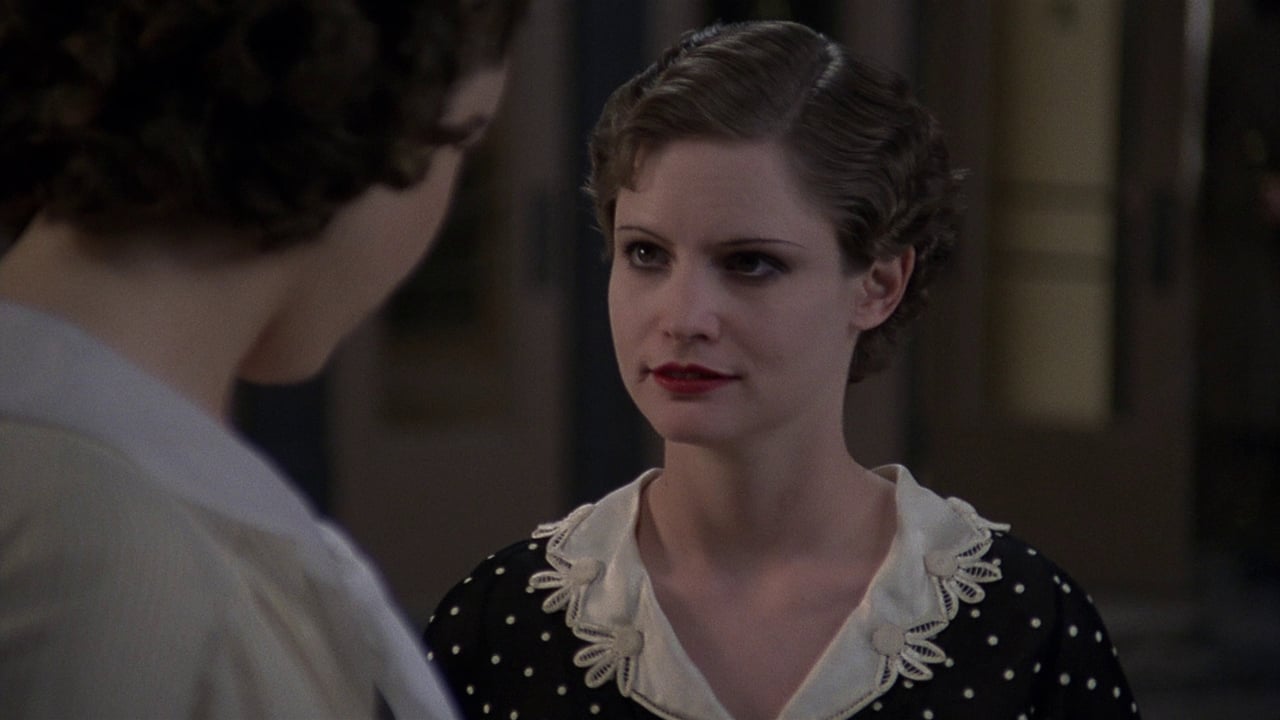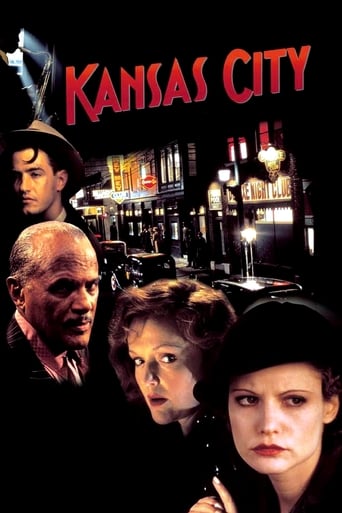

Absolutely brilliant
... View MoreA lot of fun.
... View MoreThere are women in the film, but none has anything you could call a personality.
... View MoreStory: It's very simple but honestly that is fine.
... View MoreA kidnapping and a robbery move the plot forward in a film that's less about plot than about cultural ambiance. "Kansas City" is mostly a cinematic expression of place and time. It's 1934, when gangsters and jazz ruled and Blacks and Whites went their separate ways.Visuals are very dark. And though the film is in color, tints are muted, which conveys a nostalgic, sentimental mood. The thin plot takes place largely at night. And the plot alternates with dark interior scenes at the Hey Hey Club, a risqué, all-Black speakeasy where an all-Black band jives free-form jazz, and where illegal gambling fills the back rooms.None of the characters are sympathetic. But I don't think they're supposed to be. They're archetypes, models of desperate people in desperate times. A gun-wielding gangster's girl named Blondie (Jennifer Jason Leigh) wants to be like Jean Harlow. Mrs. Stilton (Miranda Richardson) is a wealthy, spaced-out politician's wife. Seldom Seen (based on a real-life person and played by Harry Belafonte) is the cigar smoking godfather who rules the dark, smoky Hey Hey Club with an iron fist and who likes to stand around giving lectures to people.The script's dialogue is mostly subtext, with message directed less at other characters than at viewers. And, as in other Altman films, then-current politics dance around the edges of the seedy story. The overall tone mixes depression with desperation.For me this is an easy film to judge. The characters and plot I cared for not at all. Jennifer Jason Leigh was painful to watch. And though the jazz is performed with great competence, its free-form, improvisational style is too contemporary to reflect the 1930s. On the other hand, Miranda Richardson gives a fine performance. Attention to detail in costumes, sets, props, and storefront exteriors make the film come alive with era realism. And lighting is absolutely terrific.If you go into this movie expecting a deep story and well-constructed plot, you'll be disappointed. Absorb the overall texture of the film's visuals. "Kansas City" is a terrific visual portrait of a specific place at a specific time.
... View MoreHaving read all the reviews and seen the rating given this film by even more viewers, it would seem that many viewers are not au courant with the style of Jean Harlow and/or do not have the patience necessary to appreciate some films which do not move along at a quick clip. This would seem to be Altman's tribute to his hometown and to the period when he was a kid-he would have been 9 in 1934.Altman's take on the outre political corruption in Kansas City at that time would seem to be of a sort with the corruption facilitated by the Pendergras machine of the time. His depiction of black characters as autonomous, strong characters is refreshing. Harry Belafonte's mob boss Seldom Seen has to be one of the most ruthless characters seen on celluloid in recent years. Belafonte is at the top of his game, his smoky baritone all the more ominous for his low-key manner. Belafonte really deserved an Oscar nomination for his performance in this movie. One of the many aspects to recommend this film is the music that lit up Kansas City at that time-jazz. The music, featuring Lester Young, Coleman Hawkins, and even a very young Charlie Parker before he was a musician, is electric. The musicians-played by world-class musicians like Joshua Redman, David 'Fathead' Newman, and Christian McBride, electrify the scenes they are in, particularly in one duel which continues until daybreak. The musical scenes are truly magical and electric. We get a sense of the energy and vibrance in the Kansas City music scene at that time.Altman also tweaks notions of race by having white Johnny Flynn (an almost silent Dermot Mulroney) attempting to knock off a mob underling while wearing blackface. Altman considers race and is not afraid to depict and play around with it. The very fact that he is willing to consider its existence and status in society is interesting in itself. There are many black characters, many given great depth and range. Altman adds depth to our understanding of race and fleshes out depiction of people of color in ways that the vast majority of directors do not even acknowledge or consider. This makes the film valuable in and of itself.The film's plot revolves around the kidnapping of the Missouri governor's wife Caroline Stilson (Miranda Richardson) who is kidnapped to pressure the Governor to release Blondie's husband (Dermot Mulroney's Jonny Flynn) who has been caught after trying to rip off one of Seldom Seen's mob lieutenants. Blondie thinks that taking the governor's wife hostage will cause the governor to take the release of her husband more seriously.Some people don't like Jennifer Jason Leigh's performance in this movie, suggesting that it is difficult to understand her. I think that was intentional on her part-an effort to pay tribute to the work of Jean Harlow who was from Kansas City and who we see in a movie that Caroline and Blondie are watching. It's clear that Jean Harlow was attempting to depict a tougher veneer than she really had, as we see as Blondie's tough outer shell collapses as the movie progresses. I found it a very original, Oscar-worthy, performance. Miranda Richardson's depiction of a depressed, drug-addled, lonely political wife who ultimately turns out to know more than she lets on is very compelling. The chemistry between her and Leigh is electric and Richardson's role is very interesting. She delivers an excellent performance in an unusual role.Altman interweaves story lines-those of Seldom Seen and Jonny Flynn on the one hand, and Caroline Stilson and Blondie on the other-expertly-linking them effortlessly. This is one of Altman's greatest strengths-tying in disparate story lines and making connections where they might be less obvious to most filmmakers. Altman makes connections among figures where most directors wouldn't see them.I don't think this film is on the level of his tours de force in Gosford Park, Short Cuts, The Player, MASH, and Nashville, but Altman was always more about depicting a milieu and setting a scene and if his story did not have the pyrotechnics of some of many films in theaters at the time, he didn't care. This film smolders quietly, suggesting a city rotting from the inside out as evidenced by the political and criminal malfeasance which are so brazen in the picture. Altman tells rich, colorful stories and this one is no exception.
... View MoreRobert Altman's Kansas City is not a terrible movie by any stretch of the imagination and for any other director it would be a minor triumph. Yet, given the pedigree he has provided for himself, particularly with films such as MASH, McCabe & Mrs. Miller, Nashville and 3 Women on his resume, I hold his films to a higher order than most.Perhaps for that reason most of all, I was quite disappointed by this outcome. Jennifer Jason Leigh and Miranda Richardson star as small-time hoodlum and rich politician's wives, respectively, with Leigh taking Richardson hostage in hope that her husband will be released by the notorious gangster Seldom Seen. However, all this is simply a contrivance for what Altman is really after, which seems to me to be the context and feeling of the city of Kansas City in the 1930s when Jean Harlow movies played in the local cinemas and voting was a high-stakes gamble that if gone wrong had very serious consequences.In terms of the film itself, I would consider this film to suffer from the Hudsucker Proxy syndrome: it looks fantastic with the sets and costumes all perfectly realizing the era in which it attempts to capture. Yet, the story is almost thrown together with really not attempt to clarify or make known exactly what is happening. I understand this is Altman's style, particularly for this film, but in order to string the movie along and maintain audience interest, it certainly would have helped to include a more cohesive story line. Also, Jennifer Jason Leigh doesn't fit this part in my opinion, coming off more annoying and self-conscious than sympathetic and interestingly quirky. Her dialogue and delivery seem to come right out of the 1990s and have almost no place in the setting of the rest of the characters.I admire Altman as a director too much to call this film a disaster but it is by far the weakest of all his films I have seen and makes me question why he decided to make this film. Perhaps because he grew up in Kansas City in the 1930s or he felt interested in gangsters, jazz and the setting of a growing town prior to World War II. Whatever the reason, I was frequently out of touch with the story and can really give no compelling reason to seek it out as one of Altman's finer works.
... View MoreRobert Altman's depression-era flick,set in his hometown,is a somewhat tangled,hard to embrace film that is long on authenticity and substance but short on "hooks" that is going to get the average viewer.The characters are tough to develop any real feel for. Unhinged and desperate,Blondie O'HAra(Jennifer JAson Leigh) kidnaps a rich,heavily soused politician's wife(Miranda Richardson,who's very strong here) with the misguided idea that this will free her dense,scheming boyfriend/husband JOhnny(Dermont Mulroney,who barely speaks in this film). She ends up crossing both the Black gangsters of the town,led by a charismatic tough called Seldom Seen(HArry Belafonte) and the political machine that she's trying to manipulate. The results are fairly predictable;it's the interplay between Blondie and Mrs.Stinson as Blondie tries to wait out her scheme that becomes of more interest. Along the way,you get a brief glimpse of the violence,corruption and poverty that is rampant in the area in the post-Prohibition,pre-WWII urban Midwest. Steve Buscemi's turn as a loud-mouthed saloon owner and Pendergast machine lackey who is married to Blondie's sister is strong(As most of his turns in films are)and way too brief. IN sum,this movie is a worthy watch,but ONLY if one is willing to ride along with the difficult situation as it is laid out. I have not seen that many Altman movies,but I would say I got more out the stories of THe PLayer,Short Cuts or (my personal fave)Cookie's Fortune. The music,however is very strong and practically takes a life of its own,as no fewer than nine established jazz musicians(Kevin Mahogany,Cyrus Chestnut,Ron CArter among them) jam on tunes of(or styled around)the era. If you enjoy jazz,this film--and even more so the soundtrack--is a must to watch and listen.
... View More